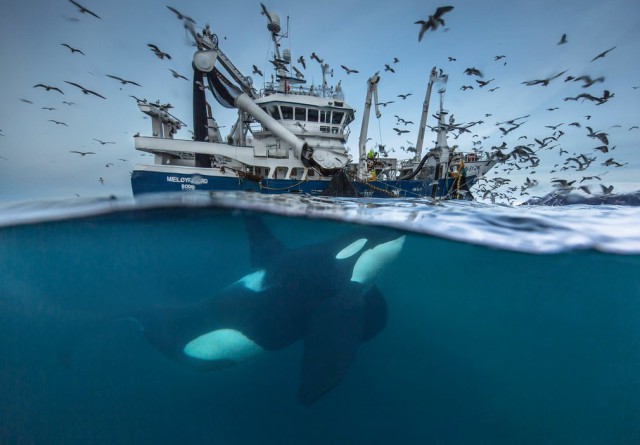
2016 National Geographic Nature Photographer of the Year National Geographic has selected the winners of its 2016 Nature Photographer of the Year competition. In addition to overall winners, there were also selections for landscapes, environmental issues, action and animal portraits.
This year's grand prize winner was Greg Lecoeur's 'Sardine Run. '
Grand Prize + 1st Place for Action photography: Greg Lecoeur: 'Sardine Run'
During the sardine migration along the Wild Coast of South Africa, millions of sardines are preyed upon by marine predators such as dolphins, marine birds, sharks, whales, penguins, sailfishes, and sea lions. The hunt begins with common dolphins that have developed special hunting techniques to create and drive bait balls to the surface. In recent years, probably due to overfishing and climate change, the annual sardine run has become more and more unpredictable. It took me two weeks to have the opportunity to witness and capture this marine predation.
2016 National Geographic Nature Photographer of the Year
First Place, Animal Portraits: Varun Aditya: 'Dragging you deep into the woods!'
I shot this at Amboli, Maharashtra, India, on July 24, 2016, during a morning stroll into the blissful rain forest. Ceaseless drizzles dampened the woods for 10 hours a day; the serene gloom kept me guessing if it was night or day. The heavy fog, chilling breeze, and perennial silence could calm roaring sprits. And there I saw this beauty. I wondered if I needed more reasons to capture the habitat, for I was blessed to see this at the place I was at. I immediately switched from the macro to the wide-angle lens and composed this frame.
2016 National Geographic Nature Photographer of the Year
1st Place, Environmental Issues: Vadim Balakin, 'Life and Death'
These polar bear remains have been discovered at one of the islands of northern Svalbard, Norway. We do not know whether the bear died from starving or aging, but more likely if we see the good teeth status, it was from starving. They say nowadays that such remains are found very often, as global warming and the ice situation influence the polar bear population.
2016 National Geographic Nature Photographer of the Year
1st Place, Landscape: Jacob Kaptein, 'Struggle of Life'
Last year I participated in the Marius van der Sandt Beurs. This scholarship stimulates photography by young photographers. For a whole year I was guided by some excellent nature photographers to realize a project I wanted to accomplish. I chose a natural stream restoration project of a nature organization in the Netherlands. The first time I entered this patch of forest, I immediately saw this little beech. I came back several times to photograph it. One evening, just after sunset, all the light conditions were perfect. I stood in the cold water for more than an hour making many photos while I experimented with different shutter speeds.
2016 National Geographic Nature Photographer of the Year
2nd Place, Action: Tori Shea-Ostberg: 'Approach'
An EF2 tornado bears down on a home in Wray, Colorado, on May 7, 2016. As soon as we were safe, as the tornado roared off into the distance through a field before roping out, we scrambled up the hill to check on the residents. Thankfully, everyone was all right, and we were grateful for that. As I was checking in with a young woman coming out of the basement, we became very aware of a strong new circulation right above our heads. We needed to run for cover and did so before saying a proper goodbye.
2016 National Geographic Nature Photographer of the Year
2nd Place, Animal Portraits: Michael O'Neill: 'Proud Mama'
A female peacock bass guards her brood in a Miami, Florida, freshwater lake. She will protect her young fry from a variety of predatory fish until they are large enough to fend for themselves. This tropical freshwater species, also known as the peacock cichlid, was introduced in Florida in the mid-1980s from South America to control the tilapia population, another invasive species. Throughout its native range (and in Florida) it’s a prized sportfish known for its fighting spirit.
2016 National Geographic Nature Photographer of the Year
2nd Place, Environmental Issues: Chris McCann: 'Outside Facebook HQ'
Eighty percent of the San Francisco Bay Area wetlands—16,500 acres—has been developed for salt mining. Water is channeled into these large ponds, leaves through evaporation, and the salt is then collected. The tint of each pond is an indication of its salinity. Microorganisms inside the pond change color according to the salinity of its environment. This high-salinity salt pond is located right next to Facebook headquarters, where about 4,000 people work every day.
2016 National Geographic Nature Photographer of the Year
2nd Place, Landscape: Alessandro Gruzza: 'Wild Rink'
The first cold days of winter have frozen the surface of a pond, and the first snowfall has revealed its delicate beauty. In low-pressure conditions, southwest winds push the clouds against the vertical peaks of the Pale di San Martino. At dusk, a long shutter speed enhances the movement of the clouds around Cimon della Pala, one of the highest peaks in the Dolomites.
You can see additional photos from the competition on National Geographic's website.
. dpreview.com2016-12-10 14:00





